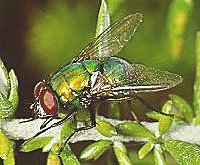|
Lucilia cuprina (Sheep blowfly)
Life
> Eukaryotes >
Opisthokonta >
Metazoa (animals) > Bilateria > Ecdysozoa
> Panarthropoda > Tritocerebra > Phylum:
Arthopoda > Mandibulata >
Atelocerata > Panhexapoda >
Hexapoda
> Insecta (insects) > Dicondyla > Pterygota >
Metapterygota > Neoptera > Eumetabola > Holometabola > Panorpida > Antliophora
> Diptera (flies) >
Brachycera
> Muscomorpha > Eremoneura > Cyclorrapha
> Schizophora > Oestroidea > Family: Calliphoridae
|

Adults.
The adult flies emerge from the pupae and mate.The female fly lays her eggs in
carcasses, wounds, and necrotic or soiled tissue, faeces, and even our foodstuffs.
The full cycle can be completed within 7 days but if
temperatures are low, the third instar larvae, the pupae or the adults will hibernate
until conditions warm up. |
The eggs hatch in 8 hours to 3
days, depending on general conditions and temperature. |
| The larvae begin feeding
immediately and grow rapidly to maturity within 2 to 19 days, again depending on
conditions such as temperature and food supply. |
Pupa.
At the end of the third instar, the larvae
leave the host and pupate in the soil just below the surface. However, they
might not be able to get to the soil if, for example, they are trapped in a
refuse removal container and they will simply pupate where they can. Pupation
time also varies and depends on temperature. It can be as brief as a few days. |
The Sheep blowfly is indigenous to Africa but has spread
to Asia and Australia, where it is a major pest species. In South Africa it is problematic
in a number of ways:
- Blowfly strike in sheep. The female flies lay their eggs
on the sheep in damp, protected areas soiled with urine and
faeces (under the tail). This results in festering sores as the larvae lacerate
the skin and this is the primary reason for the early removal of lambs' tails.
The larvae (maggots) tunnel into the host's tissue causing irritating
lesions. After about the second day bacterial infection occurs and if left
untreated causes toxemia or septicemia. This leads to
anorexia and weakness and if untreated will lead to death. South Africa is one of the largest wool producing
countries in the world and between 2% and 15% of wool sheep are affected by
blowfly strike annually resulting in a reduction in wool quality and wool
loss.
- Transmission of the disease anthrax. The Sheep
blowfly is a well-known vector of anthrax, a disease
carried by sheep, goats and cattle, and infectious to people, causing death if
left untreated.
- Transmission of diseases in urban environments. Lucilia
cuprina is suspected of spreading diseases such as gastroenteritis. If
it only occurred in low numbers, this would not be such a problem, but
populations of this fly in cities such as Cape Town are at very high levels
due to unsanitary conditions and refuse collection practices. In summer
these flies can pass through an entire life cycle in a week so that the
current practice of weekly collection of refuse in Cape Town means
that flies are breeding in large numbers before the refuse is collected.
Their practice of settling on dog faeces, decaying matter and then your food
in the kitchen means that they can easily transmit undesirable organisms.
There are huge sanitary problems in informal squatter camps in Cape Town
which encourage breeding of this fly and the close proximity of homes means
that these flies can readily spread disease through a community. For
more information see Fly problem in Cape
Town.
Text by Margie Cochrane and Hamish Robertson |
